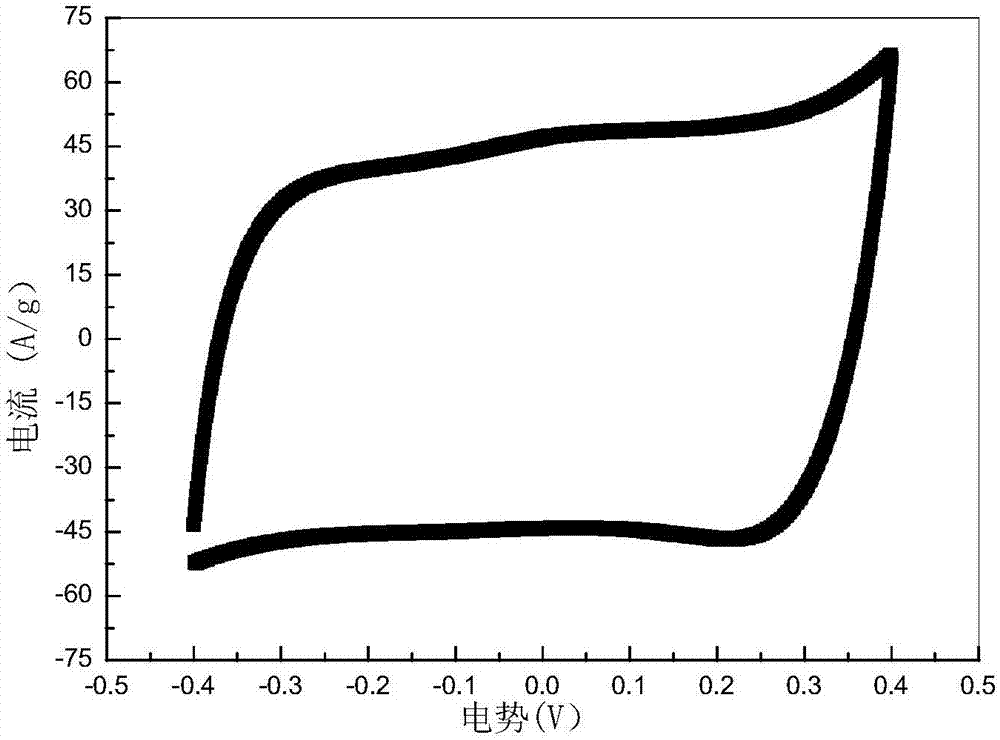Method for preparing high-capacity self-supporting manganese dioxide/carbon composite electrode
A manganese dioxide, self-supporting technology, applied in the field of electrochemistry, can solve problems such as poor contact between electrode active materials and current collectors, unfavorable charge balance ion transfer, and affecting electrode charge and discharge performance, so as to optimize electrochemical reaction impedance, High specific capacitance, the effect of improving stability
- Summary
- Abstract
- Description
- Claims
- Application Information
AI Technical Summary
Problems solved by technology
Method used
Image
Examples
Embodiment 1
[0039] Formulated with MnSO 4 and CeSO 4 and sulfuric acid mixed aqueous solution, the concentration of manganese sulfate in the mixed solution is 0.5mol / L, the concentration of cerium sulfate is 0.01mol / L, and the concentration of sulfuric acid is 0.5mol / L. Cut the carbon paper into an area of 4×1cm 2 The carbon paper tape is used as a current collector, and the current collector is ultrasonically washed with 10% sulfuric acid aqueous solution and acetone in sequence, and finally rinsed with water and dried. Use an area of 4×4cm 2The titanium mesh electrode is the counter electrode, the above mixed solution is the electrodeposition solution, and the current collector after surface cleaning is the anode (the working area is 1×1cm 2 ), conduct constant current anodic oxidation electrodeposition, the temperature of the electrodeposition solution is 5°C, and the current density is 4mA / cm 2 , the electrodeposition time is 2 minutes. After the electrodeposition is complete...
Embodiment 2
[0046] The operation process is the same as in Example 1, except that the lanthanum sulfate used replaces cerium sulfate, and the concentration of lanthanum sulfate in the mixed solution is 0.05mol / L, and the concentration of sulfuric acid is 1mol / L. The concentration of lanthanum sulfate in the hydrothermal treatment solution is 0.1mol / L, the hydrothermal treatment temperature is 180°C, and the hydrothermal treatment time is 12 hours to obtain a composite electrode. The Mn in the composite electrode 4+ / Mn 3+ The ratio is 3.7:1;
[0047] The specific capacitance of the obtained electrode active material at 2mV / s is 330.2F / g, and the cyclic voltammetry curve remains approximately rectangular when the scan rate is increased to 200mV, and the capacity retention rate is 64.1%.
Embodiment 3
[0049] The operation process is the same as in Example 1, except that potassium sulfate used replaces cerium sulfate, and the concentration of potassium sulfate in the mixed solution is 0.1mol / L, and the concentration of sulfuric acid is 3mol / L. The concentration of potassium sulfate in the hydrothermal treatment solution is 0.2mol / L, the hydrothermal treatment temperature is 120°C, and the hydrothermal treatment time is 24 hours to obtain a composite electrode. The Mn in the composite electrode 4+ / Mn 3+ The ratio is 4.8:1;
[0050] The specific capacitance of the obtained electrode active material at 2mV / s is 351.2F / g, and the cyclic voltammetry curve remains approximately rectangular when the scan rate is increased to 200mV, and the capacity retention rate is 60.2%.
PUM
| Property | Measurement | Unit |
|---|---|---|
| radius | aaaaa | aaaaa |
Abstract
Description
Claims
Application Information
 Login to View More
Login to View More - Generate Ideas
- Intellectual Property
- Life Sciences
- Materials
- Tech Scout
- Unparalleled Data Quality
- Higher Quality Content
- 60% Fewer Hallucinations
Browse by: Latest US Patents, China's latest patents, Technical Efficacy Thesaurus, Application Domain, Technology Topic, Popular Technical Reports.
© 2025 PatSnap. All rights reserved.Legal|Privacy policy|Modern Slavery Act Transparency Statement|Sitemap|About US| Contact US: help@patsnap.com


